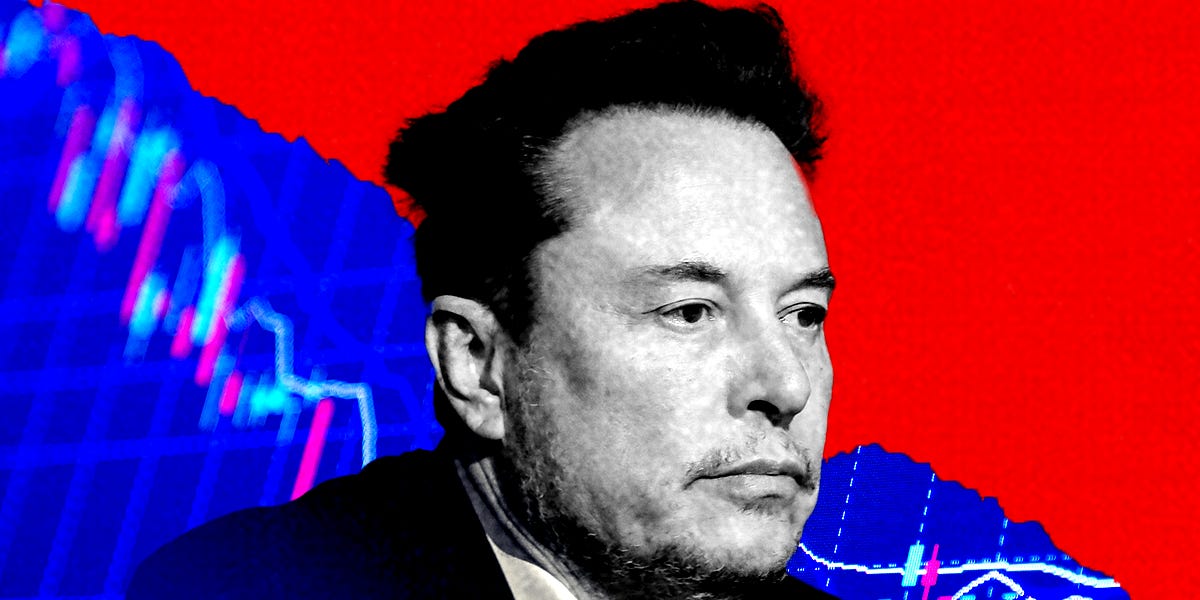If Elon Musk has a secret rescue plan for Tesla hidden away, now would be a great time to show it to the world.
On Tuesday, the company is due to report first-quarter earnings for Tesla after a decisively brutal year so far that’s left his electric vehicle maker looking like a shell of its former self.
Since the start of the year, Tesla’s share price has been in freefall, sliding more than 40%, leaving it worth about $460 billion. Musk’s own fortune has suffered a $61 billion drop too, though he’s still the world’s fourth-richest person.
Tesla is facing a host of problems.
Demand for electric vehicles has seemingly been vaporized, with deliveries of Tesla’s vehicles plummeting hard and fast. This month, Tesla said it delivered about 387,000 vehicles in the first three months of the year, marking a 20% decline from the previous quarter.
As a result, Tesla is expected to report a 40% profit drop on Tuesday, per Bloomberg, as well as its first revenue drop in four years. Last week, it emerged that it was laying off more than 10% of its staff globally as it adjusts to this new reality.
After the job cuts were announced last week, Wedbush analyst Dan Ives said Wall Street needed to know the “rationale for the cost-cutting, the strategy going forward, product roadmap, and an overall vision from Musk” on its investor call.
More price cuts
The demand issue has been particularly prominent in one of Tesla’s most important growth markets, China. Musk has engaged in a high-risk price war in the country with local rivals such as BYD as they win more buyers with cheaper — and, some say, better — vehicles.
Just this weekend, Tesla slashed the prices of its Model 3 and Model Y vehicles in China that previously sold for 245,900 yuan ($33,900) and 263,900 yuan ($36,500) respectively. It also cut prices in the US and Europe too.
Those cuts look like a significant move to boost sales after a punishing year for Tesla. But they might not be enough to stop a full-blown car crash.
Investors have grown skeptical of Musk’s wider strategy to fulfill his ambition of popularizing electric vehicles for the mass market, which would see Tesla hitting an extraordinary sales goal of 20 million EVs per year by 2030.
In part, it’s because Musk’s promises of delivering a mass-market car significantly cheaper than Tesla’s current offerings look less certain than ever.
Robotaxi dreams
As recently as November, there had been suggestions that Tesla planned to build a sub-$30,000 car at its Berlin factory, but a Reuters report this month said Tesla plans to pivot the focus of its small-vehicle platform to robotaxis instead.
Though Musk — who has planned a big robotaxi event for August — denied the report, the emphasis on driverless cars has left people close to the company feeling “unsettled by the changes the CEO wants to push through,” Bloomberg reported.
Autonomous driving has been a long-standing interest for Musk, but scaling such technology has proven challenging for the wider industry. General Motors’ autonomous unit paused operations in November over regulator concerns after a collision, for instance.
To top it all off, Tesla is voluntarily recalling all the near-4,000 Cybertrucks it’s so far produced over a fault with their accelerators, the US National Highway Traffic Safety Administration said.
For most CEOs, these issues would be plenty to keep them awake at night. But Musk also faces several other distractions in the face of a big legal battle over his Tesla compensation package, retaining advertisers at X, as well as making headway in the AI industry with Grok.
Will Musk prioritize Tesla over everything else? We’re about to find out.




